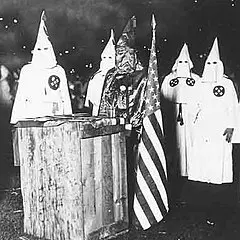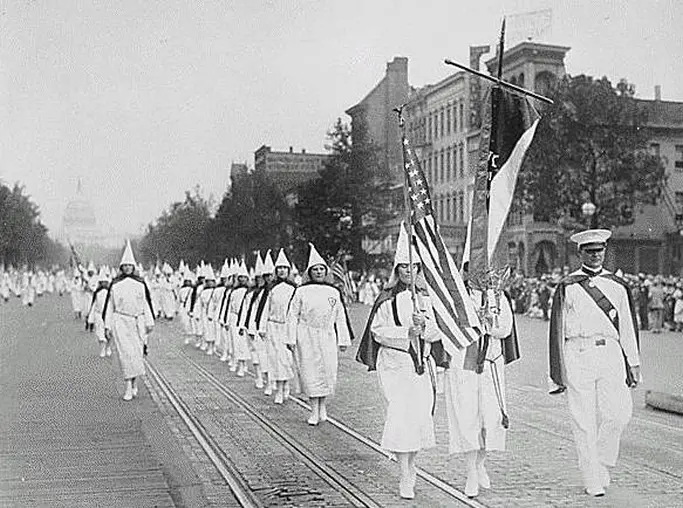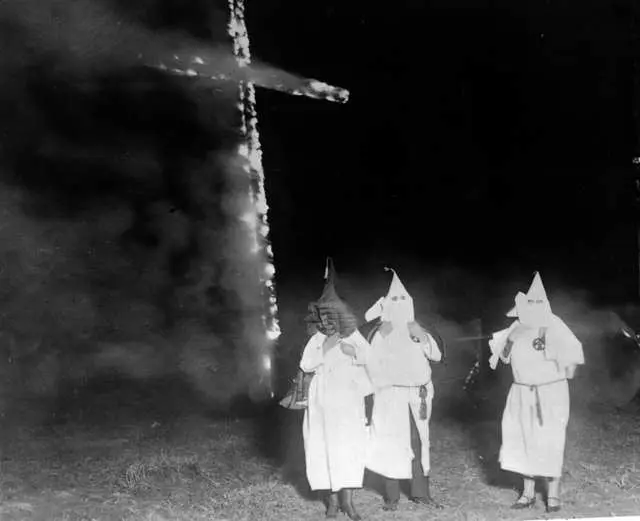
The Ku Klux Klan – commonly shortened to the KKK or the Klan – is an American white supremacist terrorist and hate group whose primary targets are African Americans, Jews, Latinos, Asian Americans, Catholics, Native Americans as well as immigrants, leftists, homosexuals, Muslims, and atheists.
Three Distinct Eras
The Klan has existed in three distinct eras. Each has advocated extremist reactionary positions such as white nationalism, anti-immigration and — especially in later iterations — Nordicism, antisemitism, anti-Catholicism, Prohibition, right-wing populism, anti-communism, homophobia, Islamophobia, Anti-Progressivism and anti-atheism. Historically, the first Klan used terrorism — both physical assault and murder — against politically active blacks and their allies in the Southern United States in the late 1860s. All three movements have called for the “purification” of American society, and are all considered right-wing extremist organizations. In each era, membership was secret and estimates of the total were highly exaggerated by both friends and enemies.
The First Klan
The first Klan was established in the wake of the American Civil War and was a defining organization of the Reconstruction era. Organized in numerous chapters across the Southern United States, it was suppressed through federal law enforcement around 1871. It sought to overthrow the Republican state governments in the South, especially by using voter intimidation and targeted violence against African-American leaders. Each chapter was autonomous and highly secret as to membership and plans. Members made their own, often colorful, costumes: robes, masks and conical hats, designed to be terrifying and to hide their identities.
The first Klan had mixed results in terms of achieving its objectives. It seriously weakened the black political leadership through its use of assassinations and threats of violence, and it drove some people out of politics. On the other hand, it caused a sharp backlash, with passage of federal laws that were a success in terms of “restoring order, reinvigorating the morale of Southern Republicans, and enabling blacks to exercise their rights as citizens”. It has been argued that the Klan was a political failure and therefore was discarded by the Democratic Party leaders of the South.

The Second Klan
The second Klan started small in Georgia in 1915. It grew after 1920 and flourished nationwide in the early and mid-1920s, including urban areas of the Midwest and West. Taking inspiration from D. W. Griffith’s 1915 silent film The Birth of a Nation, which mythologized the founding of the first Klan, it employed marketing techniques and a popular fraternal organization structure. Rooted in local Protestant communities, it sought to maintain white supremacy, often took a pro-Prohibition and pro-compulsory public education stance, and it opposed Jews, while also stressing its opposition to the alleged political power of the pope and the Catholic Church. This second Klan flourished both in the south and northern states; it was funded by initiation fees and selling its members a standard white costume. The chapters did not have dues. It used K-words which were similar to those used by the first Klan, while adding cross burnings and mass parades to intimidate others. It rapidly declined in the latter half of the 1920s.
The second KKK preached “One Hundred Percent Americanism” and demanded the purification of politics, calling for strict morality and better enforcement of Prohibition. Its official rhetoric focused on the threat of the Catholic Church, using anti-Catholicism and nativism. Its appeal was directed exclusively toward white Protestants; it opposed Jews, blacks, Catholics, and newly arriving Southern and Eastern European immigrants such as Italians, Russians, and Lithuanians, many of whom were Jewish or Catholic. Some local groups threatened violence against rum runners and those they deemed “notorious sinners”; the violent episodes generally took place in the South.
The Third (current) Klan
The third and current manifestation of the KKK emerged after 1950, in the form of localized and isolated groups that use the KKK name. They have focused on opposition to the civil rights movement, often using violence and murder to suppress activists. This manifestation is classified as a hate group by the Anti-Defamation League and the Southern Poverty Law Center. As of 2016, the Anti-Defamation League puts total KKK membership nationwide at around 3,000, while the Southern Poverty Law Center puts it at 6,000 members total.
After the decline of the national organization, small independent groups adopted the name “Ku Klux Klan”, along with variations. They had no formal relationships with each other, and most had no connection to the second KKK, except for the fact that they copied its terminology and costumes. Beginning in the 1950s, for instance, individual Klan groups in Birmingham, Alabama, began to resist social change and blacks’ efforts to improve their lives by bombing houses in transitional neighborhoods. The white men worked in mining and steel industries, with access to these materials. There were so many bombings of blacks’ homes in Birmingham by Klan groups in the 1950s that the city was nicknamed “Bombingham”.
Among the more notorious murders by Klan members in the 1950s and 1960s:
- The 1951 Christmas Eve bombing of the home of National Association for the Advancement of Colored People (NAACP) activists Harry and Harriette Moore in Mims, Florida, resulting in their deaths.
- The 1957 murder of Willie Edwards Jr., who was forced by Klansmen to jump to his death from a bridge into the Alabama River.
- The 1963 assassination of NAACP organizer Medgar Evers in Mississippi. In 1994, former Ku Klux Klansman Byron De La Beckwith was convicted.
- The 16th Street Baptist Church bombing in September 1963 in Birmingham, Alabama, which killed four African-American girls and injured 22 people. The perpetrators were Klan members Robert Chambliss, convicted in 1977, Thomas Edwin Blanton Jr. and Bobby Frank Cherry, convicted in 2001 and 2002. The fourth suspect, Herman Cash, died before he was indicted.
- The 1964 murders of Chaney, Goodman, and Schwerner, three civil rights workers, in Mississippi. In June 2005, Klan member Edgar Ray Killen was convicted of manslaughter.
- The 1964 murder of two black teenagers, Henry Hezekiah Dee and Charles Eddie Moore in Mississippi. In August 2007, based on the confession of Klansman Charles Marcus Edwards, James Ford Seale, a reputed Ku Klux Klansman, was convicted. Seale was sentenced to serve three life sentences. Seale was a former Mississippi policeman and sheriff’s deputy.
- The 1965 Alabama murder of Viola Liuzzo. She was a Southern-raised Detroit mother of five who was visiting the state in order to attend a civil rights march. At the time of her murder, Liuzzo was transporting Civil Rights marchers related to the Selma to Montgomery March.
- The 1966 firebombing death of NAACP leader Vernon Dahmer, Sr., 58, in Mississippi. In 1998 former Ku Klux Klan wizard Samuel Bowers was convicted of his murder and sentenced to life. Two other Klan members were indicted with Bowers, but one died before trial and the other’s indictment was dismissed.
- In July 1966, in Bogalusa, Louisiana, a stronghold of Klan activity, Clarence Triggs was found murdered.
- The 1967 multiple bombings in Jackson, Mississippi, of the residence of a Methodist activist, Robert Kochtitzky, the synagogue, and the residence of Rabbi Perry Nussbaum. These were carried out by Klan member Thomas Albert Tarrants III, who was convicted in 1968. Another Klan bombing was averted in Meridian the same year.
The second and third incarnations of the Ku Klux Klan made frequent references to a false mythologized perception of America’s “Anglo-Saxon” blood, hearkening back to 19th-century nativism. Although members of the KKK swear to uphold Christian morality, the group is widely denounced by Christian denominations.
Coda
Ayam Ātmā Brahma: Everything is Brahman. The illusion of separation leads to death, and as Mirabai (Bhakta Meera) told, caught again in the snare of birth. Brahman alone is true, creation is a myth (jagat mithya), and the Jivi or individual Self is Brahman. Creed, caste, colour, race, station in life, is no cause to lynch, bomb, terrorize, harass or kill another human. Whatever you do unto others, you do unto your Self.

Source
Image Credit: Wikimedia Commons/Volstand, Wikimedia Commons/NARA , Denver Library Digital Collections/Denver News
![]()

